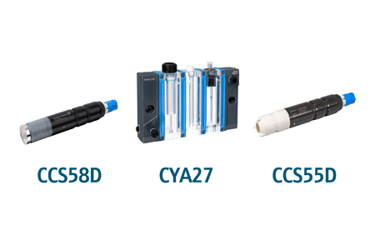Endress+Hauser Launches New Sensors And Holder Assembly For Disinfection And Water Treatment

Flowfit assembly, free bromine, and digital ozone sensors expand Endress+Hauser’s Liquid Analysis portfolio and options for end users.
Endress+Hauser released new Liquid Analysis disinfection sensors and accessories for measurement in more applications, adding the CCS55D Memosens Free Bromine sensor, CCS58D Memosens Ozone sensor, and Flowfit CYA27 assembly to its product family.
The CYA27 assembly is designed to be freely configurable, accommodating a wide range of sensors, including disinfection, pH, conductivity, and dissolved oxygen. It also offers flow monitoring and diagnostic indicator options to ensure reliable measurement, covering a wide range of disinfection applications.
CCS55D Memosens amperometric Free Bromine sensor
The Memosens CCS55D is a diverse solution for measuring free bromine in seawater, swimming pools, process and cooling water, fish farming applications, and more. The membrane-covered, low-maintenance sensor is built for stable and long-term measurement, while tried-and-true Memosens digital sensor technology ensures maximum process uptime.
With a growing global population and ever-changing environmental conditions, the demand for potable water is on the rise, and the need for seawater treatment is becoming increasingly important. Apart from desalination, systematic disinfection is an essential step and legal requirement in water treatment to protect people and systems from illness and harm.
Why measure free bromine in seawater disinfected with chlorine?
Potassium bromide, when dissolved in seawater, is present in the ionic forms of K+ and Br-. In seawater, the natural concentration of bromine ions (Br-) is very small, while the concentration of chloride ions (Cl-) is significantly higher—over 300 times the bromide concentration. Additionally, chloride ions have a much higher electron affinity than bromine ions, causing the chlorine to exist as standalone ions while the bromine combines with hydroxyl (HO+) in seawater to form toxic hypobromous acid (HOBr).
Therefore, when chlorine in its various forms—including sodium hypochlorite (bleach), calcium hypochlorite, and others—is added to seawater, the result is HOBr, not hypochlorous acid (HOCl), due to the presence of Br-.
Free bromine measurements are also made where bromine is used as a disinfection agent in fresh water, such as in swimming pools. With its wide measurement range options—from trace levels of 0 to 5 mg/L (ppm), on up to 200 mg/L—and a maximum measured error of ±2 %, or ±5 µg/l (ppb), Endress+Hauser’s Memosens CCS55D Free Bromine sensor is the ideal measuring solution for monitoring bromine levels in almost any application.
CCS58D Memosens Ozone sensor
Numerous agents are used today for water disinfection, including chlorine—the most widely employed in the US—chlorine dioxide, bromine, and ozone. Worldwide demand for ozone, in particular, is increasing, and the Memosens CCS58D Ozone sensor supports this trend with inline measurement using the Liquiline transmitter and Memosens digital sensor technology platforms.
This sensor is capable of measuring ozone concentrations in the range of 0.1 to 2.0 mg/L, with an error of ±2 %, or ±5 µg/l. This range is ideal for monitoring ozone levels in drinking water, wastewater, and utilities to ensure efficient and safe disinfection.
CYA27 Flowfit assembly – maximum flexibility, safe measurement, and easy maintenance
Endress+Hauser’s new modular Flowfit CYA27 flow assembly enables measurement of up to six parameters in process and drinking water, enabling adaptation to many process requirements. The CYA27 provides a flexible basis for the measurement of disinfection parameters, including chlorine, chlorine dioxide, ozone, bromine, and further parameters of liquid analysis, such as pH, ORP, dissolved oxygen, and conductivity.
The assembly features a status light that provides clear indication of the measuring point’s operational state. This light can be used to display flow status, showing a red light if the flow is too low, or it can be connected to a transmitter’s alarm relay to indicate the NAMUR status of the measuring point. This informs operators of process conditions at a glance, helping optimize production and mitigate potential problems.
For more information, view the CCS55D Memosens Free Bromine sensor, CCS58D Memosens Ozone sensor, and Flowfit CYA27 assembly online.
